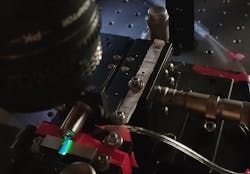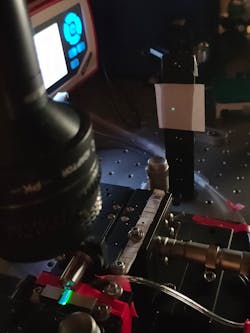In 2020, University of Twente researchers in the Netherlands came up with a supercontinuum generation method to counteract spectral stagnation, based on sign-alternating-dispersion waveguides, which enables the use of lower-power input beams.
In their method, waveguides are designed to control the dispersion of light by alternately widening and narrowing the light beam—and it significantly cuts the required amount of pulse energy compared to traditional methods.
Put it on a chip
The group’s supercontinuum generation method proved so promising they launched a spinoff, Superlight Photonics, and put it on a chip to address the undesirable baggage of supercontinuum lasers: they’re enormous, expensive, and have high peak power consumption.
“We now have a technology platform that can be used in any waveguide material matrix to lower the power requirements for wide-bandwidth lasers by factors of thousands—while also increasing the power of spectral components being generated relative to the peak (e.g., flat spectrum),” says Haider Zia, one of the researchers and now the managing director of Superlight Photonics. “This enables portable or fully integrated supercontinuum generation sources that can be used as light sources in portable optical devices that are used in a wide variety of industries from medicine to environmental sensing.”
Determined to make supercontinuum generation accessible for industry, Zia identified two bottlenecks holding it back. “First, the energy efficiency of the process is low. Large lasers that occupy an entire tabletop translate into high costs, limited-volume scaling, and large space requirements,” he explains. “Second, the spectral generation of large bandwidths associated with supercontinuum generation, its main claim to fame, is limited to approximately the 30 dB power level—which is 1000X lower in power than the main drive laser central wavelength.”
Zia also focused on increasing the efficiency of the process in CMOS-compatible integrated photonic waveguides that can be produced in volume to make supercontinuum generation accessible for small and inexpensive lasers—even the smallest fiber lasers out there or even integrated seed lasers. “I also focused on optimizing the generation so that the power of the spectral components remains high relative to the peak power wavelength—a large bandwidth at the 3 dB level, not the 30 dB level.”
This platform controls the shape of a seed laser pulse so the interaction of dispersive effects and nonlinear effects won’t lead to the stagnation of spectral generation across the length of the waveguide.“This was the main limitation causing bottlenecks,” Zia says. “Alternating the dispersion between normal and anomalous enables keeping the pulse profile within a configuration that generates spectral bandwidth at the 3 dB bandwidth continuously across large propagation lengths.”
Zia and colleagues had questions about whether the simulations of the technology “would match the experimental results of our fabricated waveguides,” he says. “The fabrication parameters—such as dispersion, losses, exact widths of the waveguides, etc.—are difficult to estimate because they fluctuate per fabrication run, even at the big silicon nitride (SiN) fabs.”
But when running an experiment, “we found the results matched, if not exceeded, our simulations’ predictions,” Zia says. “This was both a good surprise and a relief. We’re now confident of our estimation of the relevant parameters.”
Substantial visible light generation
One of the most surprising and coolest aspects Zia noticed was substantial visible light generation. While they’d planned for near-infrared-range supercontinuum generation, because SiN is extremely lossy in the visible band, the visible light generation was unexpected.
“We found narrow-band blue and green dispersive waves near the 3 dB level not predicted by our simulations,” says Zia. “And we now know they’re generated by the precise phase-matching conditions that emerge for four-wave mixing when the dispersion is varied in our method.”
These narrow-band peaks can be used to lock the supercontinuum generation spectrum to a laser source to produce very stable output. “Applications of this technology are immense,” says Zia.
FURTHER READING
H. Zia, K. Ye, Y. Klaver, D. Marpaung, and K.-J. Boller, Adv. Photon. Res. (Jan. 2023); https://doi.org/10.1002/adpr.202200296.


